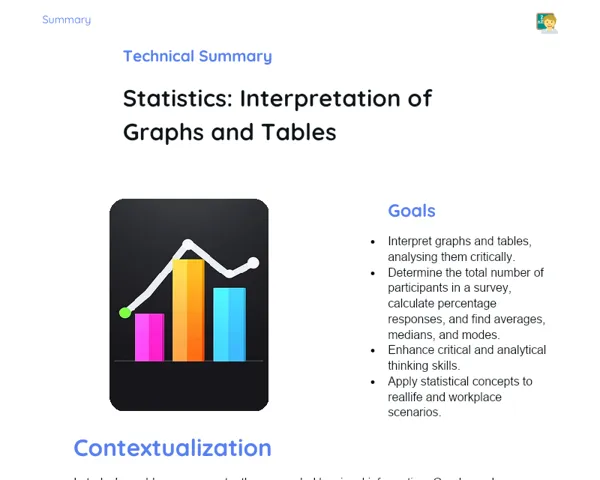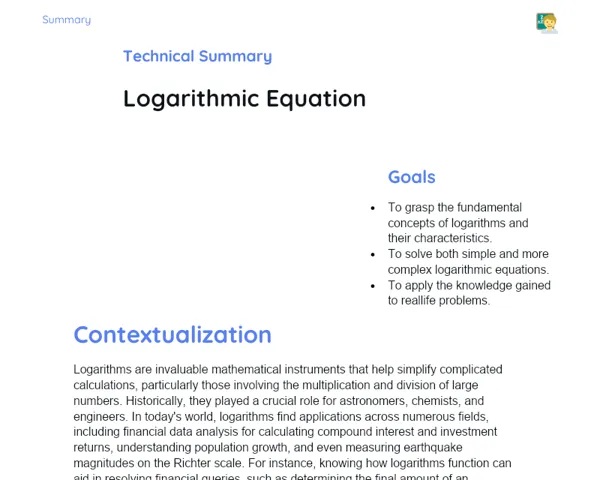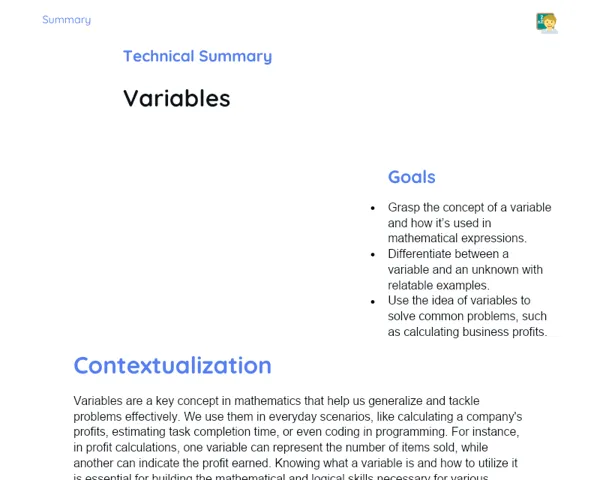Summary Tradisional | Circumscribed Polygons
Contextualization
Circumscribed polygons are geometric shapes where the sides touch an inscribed circle at a single point without crossing it. This concept is vital for grasping the interplay between various geometric shapes and their mathematical properties. In a regular polygon, all sides are equal and they touch a central circle, commonly referred to as the inscribed circle. The configuration of these shapes has numerous properties and mathematical relationships that prove beneficial in various practical scenarios.
The concept of circumscribed polygons is especially relevant in fields like engineering and architecture, where spatial optimization and balance of forces are key considerations. For instance, in many construction projects, the bases of columns can be designed as circumscribed polygons to enhance structural stability. Moreover, examining these geometric figures enhances analytical skills and fosters effective problem-solving capabilities.
To Remember!
Definition of Circumscribed Polygon
A circumscribed polygon is a geometric figure whose sides touch an inscribed circle, known as the inscribed circle. Put simply, each side of the polygon makes contact with the circle at one point without crossing it. This characteristic is essential for understanding the properties and mathematical relationships of circumscribed polygons.
In regular polygons, all sides and internal angles are equal, which allows the inscribed circle to be perfectly centred within the polygon. This symmetry aids in mathematical analysis and the practical application of these figures in various situations. Circumscribed polygons can take many forms, including triangles, squares, hexagons, and even more complex shapes.
Getting to grips with the definition of circumscribed polygons is the first step towards exploring their properties and applications. This foundational understanding enables learners to tackle more advanced topics, such as the connection between the sides of the polygon and the radius of the inscribed circle, as well as how to apply these shapes to real-world problems.
-
Circumscribed polygon: a figure whose sides contact an inscribed circle.
-
Inscribed circle: the circle which the polygon's sides touch.
-
Symmetry in regular polygons enhances mathematical analysis.
Relationship between Polygon Side and Circle Radius
The mathematical link between the side of a circumscribed polygon and the radius of the inscribed circle is fundamental in solving geometric challenges. For regular polygons, this correlation is particularly straightforward. For example, in a circumscribed equilateral triangle, the length of a side is directly proportional to the radius of the inscribed circle. This relationship can be expressed through specific formulas that connect the side length of the polygon to the circle's radius.
For a regular polygon with n sides, the length of each side (L) can be computed if the radius (R) of the inscribed circle is known. The general formula for calculating a side's length is L = 2 * R * sin(π/n), where π is the mathematical constant pi. This formula indicates that as the radius increases, so does the length of the side, while an increase in the number of sides leads to shorter side lengths.
Grasping this relationship allows students to address a range of problems, from basic calculations to more complex engineering and architectural applications. For example, determining the side lengths of a circumscribed polygon is crucial in designing structures that require precise dimensions and optimised space.
-
Understanding the link between polygon sides and radius of the inscribed circle.
-
General formula: L = 2 * R * sin(π/n).
-
Real-world applications in calculations and structural design.
Properties of Circumscribed Polygons
Circumscribed polygons have several significant properties that are useful in both theoretical and practical contexts. One notable property is the equality of the central angles formed by the inscribed circle's center and two consecutive vertices of the polygon. In a regular polygon, all these angles are equal, thus contributing to the figure's symmetry and regularity.
Another important property involves the apothem, which is the distance from the circle's center to the midpoint of one of the polygon's sides. The apothem is vital for calculating the area of regular polygons, as combining it with the perimeter allows application of specific mathematical formulas. For instance, the area of a regular polygon can be calculated as (perimeter * apothem) / 2.
Moreover, circumscribed polygons have practical applications across various fields, such as optimising space and distributing forces in engineering and architecture. Understanding these properties enables learners to apply theoretical knowledge to real-life scenarios and tackle complex issues effectively.
-
All central angles in regular polygons are equal.
-
The relationship with the apothem is key for area calculation.
-
Practical applications in optimising space and force distribution.
Mathematical Formulas
Numerous mathematical formulas are available to work with circumscribed polygons, making problem-solving and practical application of these concepts easier. To determine the perimeter of a regular circumscribed polygon, the formula used is P = n * L, where n is the number of sides and L is the length of each side. This straightforward formula simplifies the calculation of the perimeter, which is crucial in various practical scenarios.
For calculating the area of a regular circumscribed polygon, one of the most frequently used formulas is A = (P * a) / 2, where P is the perimeter and a is the apothem. This illustrates how knowledge of the apothem, combined with the perimeter, can help determine the polygon's total area. The apothem’s measure signifies the distance from the centre of the circle to the midpoint of one of its sides.
Beyond these basic formulas, more complex ones may be applied based on the specific shape of the polygon and the problem at hand. Mastering and applying these mathematical formulas is essential for efficiently solving geometric problems, particularly in practical disciplines like engineering and architecture.
-
Perimeter formula: P = n * L.
-
Area formula: A = (P * a) / 2.
-
Crucial role of the apothem in area calculations.
Practical Applications
Circumscribed polygons find a myriad of practical applications, especially in sectors like engineering and architecture. In engineering projects, understanding the relationship between the polygon sides and the radius of the inscribed circle optimizes how forces are distributed in structures, enhancing strength and stability. For instance, the bases of particular pillars can be designed as circumscribed polygons to more effectively support loads in a balanced way.
In architecture, circumscribed polygons are frequently utilised to maximise space usage. The symmetry and regularity of these shapes enable efficient, visually appealing designs—crucial elements in many architectural projects. Furthermore, applying mathematical formulas for calculating perimeters and areas facilitates meticulous planning and execution of complex endeavours.
Comprehending how circumscribed polygons are employed in real-world contexts helps learners appreciate the importance of theoretical concepts taught in the classroom. This practical grasp also hones analytical and problem-solving skills essential for various professional paths.
-
Enhancement of force distribution in engineering practices.
-
Maximisation of space in architectural designs.
-
Cultivation of analytical and problem-solving abilities.
Key Terms
-
Circumscribed Polygon: A geometric shape whose sides contact an inscribed circle.
-
Inscribed Circle: The circle that touches the sides of the polygon.
-
Apothem: The distance from the circle's centre to the midpoint of one of the polygon's sides.
-
Perimeter: The total length of all sides of the polygon.
-
Area: The measure of a polygon's internal surface.
-
Central Angle: The angle between two consecutive vertices formed at the circle's centre.
-
Regular Polygon: A figure with equal side lengths and angles.
Important Conclusions
Circumscribed polygons are geometric figures whose sides touch an inscribed circle, understanding which is fundamental for both theoretical mathematics and practical applications in engineering and architecture. The mathematical relationship between a polygon's side and the radius of the inscribed circle is crucial for solving geometric problems and optimising structural designs. Additionally, properties such as the equality of central angles and the role of the apothem in area calculations serve as powerful tools for both analysis and practical application.
Being able to calculate the perimeter and area of circumscribed polygons with specific formulas allows for efficient problem-solving. This knowledge is then applied in contexts that optimise space and manage forces in engineering and architectural projects. The practical application of these concepts develops vital analytical and problem-solving skills valuable across numerous careers.
Studying circumscribed polygons not only reinforces the crucial role of mathematics in everyday life but also demonstrates how geometric concepts are practical in real-life situations. We encourage students to deepen their understanding of this topic, exploring other shapes and their properties, while observing how these concepts manifest in the world around them.
Study Tips
-
Review basic concepts of polygons and circles to ensure comprehension of fundamental definitions and properties.
-
Practice solving problems using the provided mathematical formulas, such as those for perimeter and area, and apply them to different types of circumscribed polygons.
-
Investigate practical examples of circumscribed polygons in engineering and architecture, striving to understand how these concepts are applied in structural design.



